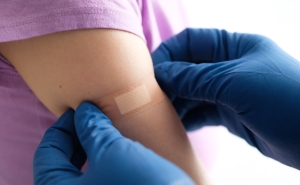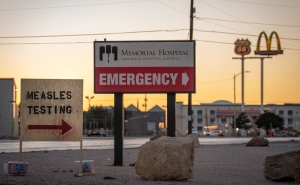How Families Can Approach ‘The Great Unmasking’

Once again, we are entering a new phase of “reopening”—and, this time, unmasking is at the heart of the changes. We are at a very different place than we were a year ago with vaccines, tests, and treatments more available, and with more knowledge about how to keep ourselves and our communities safe.
But the virus is still with us, and there are still people ineligible for vaccination (specifically, children under 5 years old) as well as people who may not mount a protective immune response to the vaccine due to underlying medical conditions. Many of these individuals and their families rightfully may not feel confident that the worst is behind us.
Parents and families may be wondering how they can continue to protect their loved ones, especially when many places are dropping mask mandates and voluntary mask-wearing may be decreasing.
Having a set framework is helpful to guide decision-making when it comes to making choices about what activities you want to prioritize, like going out to dinner or having unmasked playdates. One that we have found helpful is: protecting yourself, your family, and your community.
In this piece, we’ll break down what this “north star” looks like as we continue to make the shift from pandemic to endemic and how you can approach decision-making and risk analysis in this new context.
Protecting Yourself
For people 5 years old or older who have no issues with their immune system, the most robust protection will come from full vaccination. (With more transmissible variants like omicron at play, the definition of “fully vaccinated” should now include “boosted.”)
With three doses of an mRNA vaccine, individuals can feel pretty confident about trusting the CDC’s COVID-19 Community Level guide for making decisions about how to protect themselves. If transmission is graded green, or “low,” the only mitigation measures you need to protect you from severe illness are to keep up with your vaccines and get tested if you have symptoms.
That said, even with low transmission, with no other safety measures like masks or social distancing, there’s still the chance that you could catch COVID-19. Low risk doesn’t mean NO risk of infection, but it does mean you’re most likely well-protected against getting severely ill.
Even with “moderate” transmission, or a yellow grade, the CDC notes, fully vaccinated individuals with healthy immune systems don’t need to change their behavior. If rates tick up into that orange or “high” level, though, it’s time to bring back masks for indoor public spaces. You may also want to add in additional protections—such as mask-wearing or avoiding large indoor activities—if an infection would disrupt your plans in the next couple of weeks.
A few caveats:
- The grading system doesn’t apply to public transportation, hospitals or long-term care facilities, and other select public spaces. Masks are still required in these places—and sometimes in other locations depending on the locality—and there may be other measures in place, too.
- If you are immunocompromised, it’s better to proceed with caution. Wear a mask in public spaces if transmission is medium or high. Choose the mask with the highest filtration that fits you best for extra protection around unmasked people. (Read more about high-quality masks here.)
- If you’re exposed to COVID-19, or if you are within the first 5 days of coming out of isolation for a COVID infection, you should wear a mask in indoor public spaces until you’re in the clear. Eventually, we may normalize mask-wearing to the point that everyone will don a mask at the first sign of cold or flu symptoms, which would greatly decrease all respiratory illness transmission.
Guidance for individuals is fairly straightforward, but things get a little more complicated when adding other family members or specific circumstances to the mix.
Protecting Your Family
Things get more complicated if you have unvaccinated or immunocompromised people in your immediate orbit. The first line of defense is to get all eligible family members up-to-date on COVID vaccines as soon as possible.
But if you have kids under 5 or anyone who is immunocompromised in your household, other considerations come into play. While kids under 5 are at relatively low risk of getting severely ill, there is still some level of risk, and there’s also the chance they could spread COVID to a more at-risk family member. It’s recommended that children under 2 years old not wear masks due to a risk of suffocation, so the actions of the people who surround them are important.
Guidance suggests that if transmission rates are medium (yellow) or orange (high), everyone in the household should be masking in all public situations including daycares and schools. But as these spaces move away from universal mask mandates, unvaccinated kids may be more at risk. This means that families will need to decide for themselves what the risks are and, if needed, take precautions.
If transmission is low (green), families with unvaccinated kids can proceed with caution and perhaps prioritize the activities most necessary, like school, while cutting back on other risks, like travel and attending gatherings unmasked, to minimize disruption from a COVID-19 illness.
If transmission is medium or high, families with unvaccinated kids should continue with additional strategies to keep kids safe, like wearing masks at school or during indoor play dates, arranging for outdoor playdates (rather than indoors), and avoiding large indoor gatherings.
This may also mean that families can adapt in real time, keeping masks on hand and pulling them out if a gathering becomes more crowded than originally planned, or planning to wear masks in certain more risky environments (e.g., where fewer other people are wearing masks, or places with seemingly worse ventilation or more crowded conditions), and leaving them off in other contexts (e.g., small gatherings, nearly empty stores).
Once you have a handle on how you as an individual and then you as a family will approach COVID safety, you think about the broader communities you’re part of.
Protecting Your Community
This is where quarantining and isolation come in, especially for those who have been exposed and are not up-to-date on their vaccines.
At a glance, the CDC’s “When To Stay Home” chart is a good guide for how to treat an exposure. If exposed and not fully vaccinated, quarantining for 5 days and wearing a mask around others in the home are still recommended to reduce spread. Individuals must not travel and should avoid others until they’ve been tested (at least 5 days after known contact) and watch for symptoms for 10 days.
The good news is that if you were exposed to COVID-19 and you’re fully vaccinated (including a booster!), there’s no need to quarantine or take precautions unless you have symptoms. However, if there are unvaccinated people in your household or immune suppressed vaccinated people, you may want to exercise caution, including wearing a mask for a 5 days when in your household and then get tested for COVID-19, and increasing ventilation in your household.
The same guidance applies for those who have had confirmed COVID within the past 90 days. You may want to keep some rapid tests on hand— many jurisdictions, including the federal government, are now giving out tests for free. They can be used to check for infection rapidly if you develop symptoms, or a few days after a known exposure.
It’s important to note that, for the time being, this guidance still stands regardless of your area’s transmission levels. Even if transmission is low, if you are unvaccinated or not fully vaccinated, you still need to take precautions to avoid spreading COVID-19 to others both in your home and your community.
The Good News
It’s still too soon to declare the pandemic over, so continue to practice the “self, family, community” safety degrees as appropriate for your individual circumstances. Flexibility in stepping up and rolling back mitigation strategies has been essential in our response to the virus. This next phase will require that same flexibility.
But, thanks to widespread vaccination and our emergence from the omicron surge, our overall immunity to COVID-19 is much better than it was two years or even six months ago. We still need to improve vaccination and booster rates—and many parents are anxiously awaiting authorization for kids under 5 —but there are reasons to be hopeful that COVID-19 will present fewer and fewer disruptions to our everyday lives.
Elizabeth Stuart, PhD, is the vice dean for Education at the Johns Hopkins Bloomberg School of Public Health and a professor in Mental Health, Biostatistics, and Health Policy and Management. She was recently appointed as a Bloomberg Professor of American Health.
Keri Althoff, PhD ’08, MPH ’05, is an associate professor in Epidemiology at the Johns Hopkins Bloomberg School of Public Health with a joint appointment at the School of Medicine. She is the Provost’s Fellow for Research Communication at Johns Hopkins.
Lindsay Smith Rogers, MA, is the producer of the Public Health On Call podcast and the associate director of content strategy for the Johns Hopkins Bloomberg School of Public Health.





